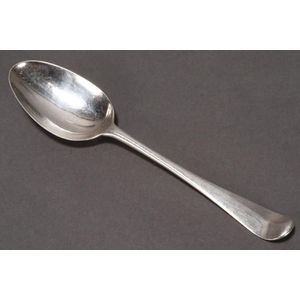George III Sterling Silver Spoon, London 1761, Rat Tail Pattern
You must be a subscriber, and be logged in to view price and dealer details.
Subscribe Now to view actual auction price for this item
When you subscribe, you have the option of setting the currency in which to display prices to $Au, $US, $NZ or Stg.
- Hallmarks - A mark stamped on articles of precious metals in Britain, since the 14th century, certifying their purity. It derives its name from the Guild Hall of the Goldsmiths' Company, who recieved its Charter in 1327 giving it the power to assay (test the purity) and mark articles of gold and silver.
The hallmark will consist of several marks, including the:
- silver standard mark, indicating the purity of the metal. Sterling silver is .925 pure silver.
- the city mark indicating the city in which it was assayed eg London, Birmingham, York etc.
- the date mark, usually a letter of the alphabet in a particular font and case,
- a duty mark, indicating whether duty had been paid to the crown, and only in use from 1784 to 1890
The piece may include an additional mark, the maker's mark, although not forming part of the hallmark, will be located in the vicinity of the hallmarks.
Sometimes silver plated items will bear faux hallmarks, often confusing those not familiar with silver markings. - George Iii - George III (1738 - 1820) was King of Great Britain and Ireland from 1760 to 1820.
- Sterling Silver - Sterling silver is a mixture of 92.5% pure silver and 7.5% of another metal, usually copper. Fine silver is 99.9% pure silver, and is relatively soft and the addition of the very small amount of copper gives the metal enough strength and hardness to be worked into jewellery, decorative and household objects.
- Rat Tail - A spoon with a flattened handle, tapering from the narrow section at the bowl, and wider as the top of the handle, that when viewed from above is of a similiar shape to a rat's tail. Also known as the Hanoverian pattern, as its manufacture spanned the reigns of George I, II and III (part) of the House of Hanover dynasty. The rat tail pattern was the forerunner to the Old English pattern.
- Marrow Spoon - A spoon with a long handle and a narrow scoop shaped bowl, used to scoop and eat marrow from the hollow centre of roasted bones. Some marrow scoops are double ended with a different shaped bowl at each end.
This item has been included into following indexes:
Visually similar items

A George III silver dessert spoon, Old English pattern; Hester Bateman, London 1776

George III hallmarked sterling silver basting spoon, William Eley & William Fearn, London, 1818-19, 110 grams and 30 cm long

Scottish provincial sterling silver sauce ladle, hallmarked Aberdeen circa 1806-40 (William Jamieson), 16 cm long, 30 grams

Imperial Russian silver soup ladle, hallmarked Moscow 1882 (Firm of Sazikov), assay master Ivan Yefimovich Konstantinov, 84 zolotnik purity, 31.5 cm long, 312 grams
